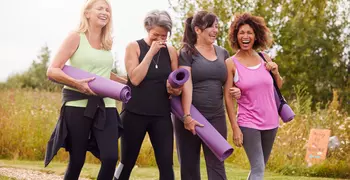Stress
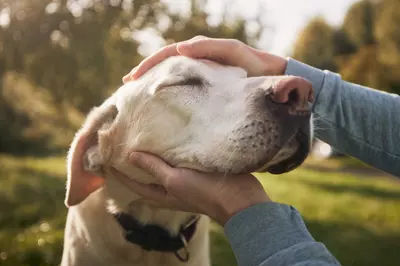
Learn Relaxation Techniques
There are many ways to enhance your healthy behaviors and reduce your reliance on destructive habits. To start, you can learn how to turn off your body's fight-or-flight reflex through breathing exercises and relaxation techniques.
Here are some simple stress-reducing strategies to help you lessen the impact of stress on your health and wellbeing.
Practice mindful relaxation
Mindful relaxation is an effective way to combat stress. With a little practice, you can learn how to shift into a relaxation mode. When done successfully, the relaxation response increases alpha brain wave activity and lowers blood pressure, pulse, respiration rate, metabolic rate, oxygen consumption, anxiety, and produces a greater sense of wellbeing.
Over time, you will develop an ability to shift into a more relaxed state in the midst of stressful situations.
Try these steps to help you achieve mindful relaxation:
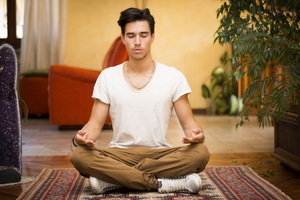 Commit to an uninterrupted length of time each day to do your practice. You might begin with five minutes and increase from there. Twenty minutes of relaxation once or twice a day is optimal.
Commit to an uninterrupted length of time each day to do your practice. You might begin with five minutes and increase from there. Twenty minutes of relaxation once or twice a day is optimal.- Choose a quiet place. Turn off the television, radio, computer, and telephone.
- Find a comfortable body position. You can sit or recline in a chair, or settle comfortably on the floor. Make sure you feel supported.
- Focus on the repetition of a word, sound, prayer, or your breath flowing in and out.
- Create a positive state of mind. While you may not always be able to block out worries or negative thoughts, you don't need to attach to them. Let them float by like clouds in the sky.
Try breathing techniques
Another way to master stress is to be aware of your breathing. When people feel panicked or unconsciously stressed, they tend to take short, shallow gasps of air. The resulting lack of oxygen restricts blood flow and causes muscles to tense. By allowing more air to enter your body, you slow down your heart rate, lower your blood pressure, and break the stress cycle.

2-minute relaxation technique
- Focus your attention on your breathing. Take a few deep breaths, exhaling slowly.
- Mentally scan your body. Notice areas that feel tense or cramped. Quietly loosen them. Let go of as much tension as you can.
- Rotate your head in a smooth, circular motion once or twice, avoiding any movements that cause pain.
- Roll your shoulders forward and backward several times. Let all of your muscles completely relax.
- Recall a pleasant thought, event, or place.
- Take deep breaths and exhale slowly.
Use imagery
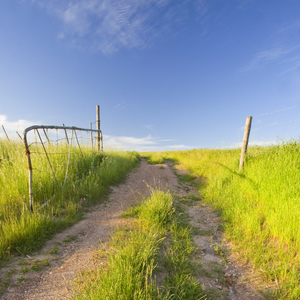 Imagery exercises use creative imagination to "picture" scenarios that relax and heal. They can be done on your own, or with a facilitator guiding you, which is called guided imagery.
Imagery exercises use creative imagination to "picture" scenarios that relax and heal. They can be done on your own, or with a facilitator guiding you, which is called guided imagery.
A common relaxation practice is to mentally picture yourself in a pleasant place that puts your mind and body at ease. For example, imagine yourself lying on a beach with the sun shining, listening to the waves. It is important to imagine a place that has a positive association for you (an ocean beach may not be a pleasant place for everyone).
Another use of imagery is when cancer patients imagine their healthy cells eating and destroying cancerous cells. Studies done with cancer patients show that the use of guided imagery markedly improves stress levels.
Add body exercises
Having awareness of where you store stress in your body is another important part of stress reduction. Learn how to release tension in your body by trying the following exercises.
- Body scan
- Progressive muscle relaxation
- Shoulders and neck relaxation
Learn more about yogaIn addition, mindful movement practices such as yoga, tai chi, and qi gong, are excellent for reducing body tension and stress and increasing flexibility and equanimity. These exercises are becoming increasingly popular and common, and they are available at many local community centers, schools, and health clubs.
Consider biofeedback
Biofeedback uses a measuring device to assess how relaxed you are and teach you how to relax more effectively. Biofeedback equipment monitors systems of which you are not normally aware, such as blood pressure, pulse, temperature, and brain wave patterns. As you practice biofeedback, you develop the ability to change these systems (for example, lower your blood pressure).
You can try a simple biofeedback exercise on your own, using a thermometer as a guide. Hold a thermometer between your index finger and thumb, and note the temperature. Then complete one of the relaxation techniques previously described. After your session, measure your temperature again.
If you are interested in further exploring biofeedback, consult with a psychologist or other health provider who works with it.
More ways to relax

Meditation exercise
Meditation can induce relaxation, and it has numerous other benefits. Listen to this mindful breathing meditation.
Sit comfortably with your feet on the floor.
Click the link below to start the audio, then close your eyes and listen. If you find your mind wandering, gently bring it back and start again.
Download an MP3 to save and play in a relaxing environment. (You will need to unzip this file once downloaded.)
Download a PDF transcript of this meditation.

Take 5: Guided imagery video
In our daily lives, we often rush from meeting to meeting, appointment to appointment, class to class, with little opportunity to catch our breath! We encourage you to Take 5 for a calmer mind.
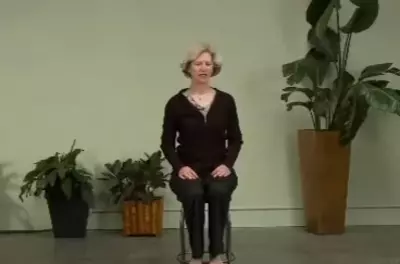
10-minute seated body scan
Learn to bring more awareness and relaxation to your body with this short video.
Benson, H. (1993). The relaxation response. In Mind body medicine. Goleman, D., Gurin, J. (ed). New York: Consumer Reports Books, 233-257.
Everly, G. S., Lating, J.M. (2012). A clinical guide to the treatment of the human stress response. New York: Springer.
Serra, D., Parris, C.R., Carper, E., Homel, P., Fleishman, S.B., Harrison, L.B., Chadha, M. (2012). Outcomes of guided imagery in patients receiving radiation therapy for breast cancer. Clinical Journal of Oncology Nursing; 16(6):617-23
Tai chi: An introduction. National Center for Complementary and Alternative Medicine. http://nccam.nih.gov/health/taichi/introduction.htm. Accessed March 29, 2013.
Yoga for health: An introduction. National Center for Complementary and Alternative Medicine. http://nccam.nih.gov/health/yoga/introduction.htm. Accessed March 29, 2013.

